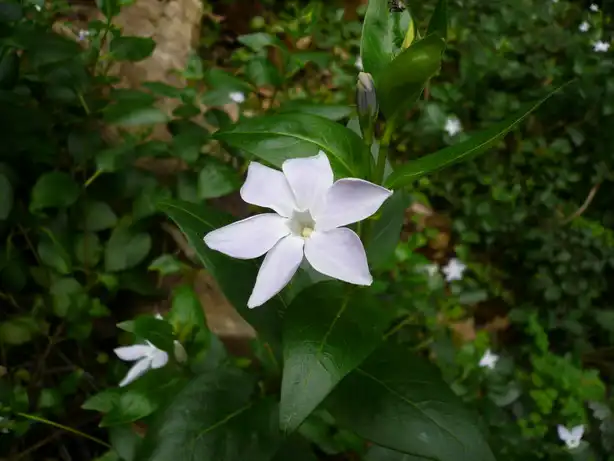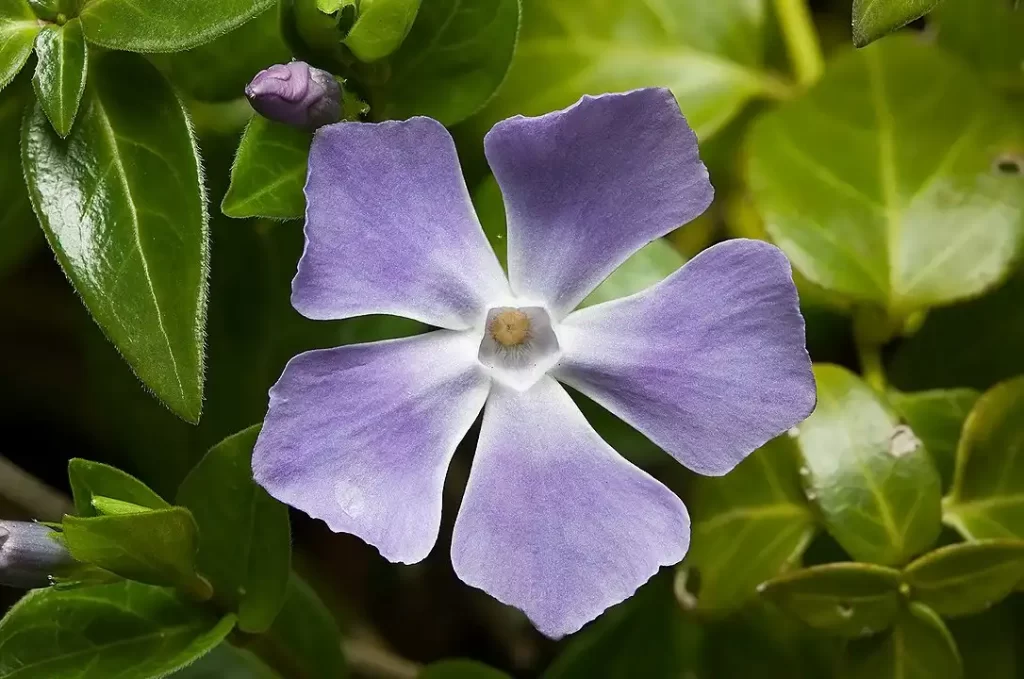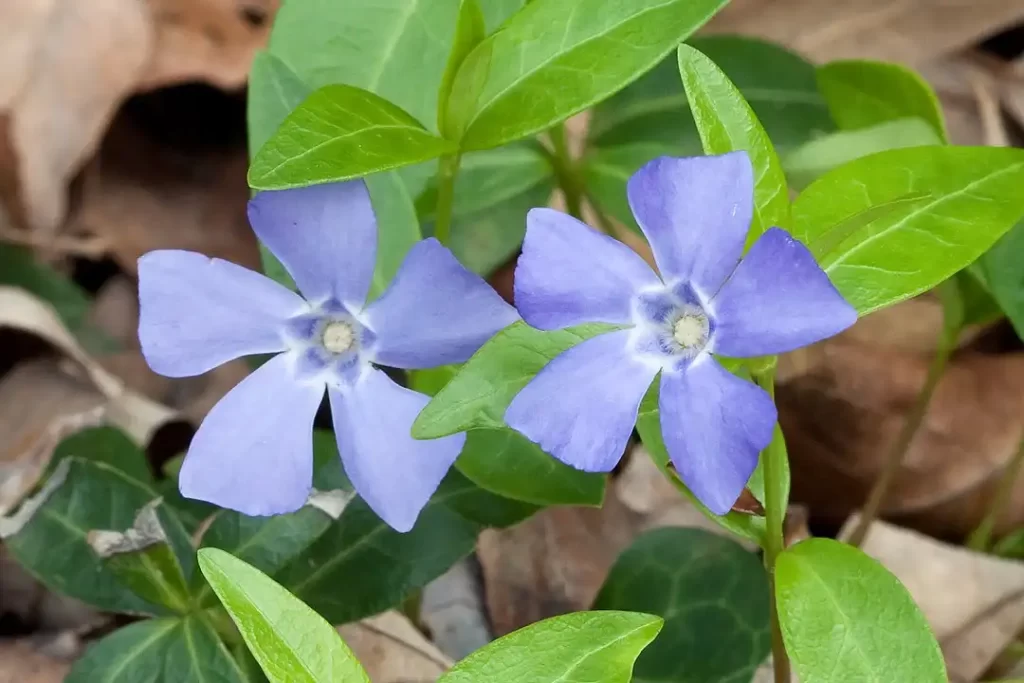The herbaceous ornamental plants called periwinkle belong to the flowering plants. This genus is also named vinca. The plant is evergreen and used as a garden cover plant. It is mostly found in Europe, North Africa, some regions of West Africa, and Central Asia. The plant is also termed a subshrub. The plant belongs to the plant family Apocynaceae.
The name of this plant group Vinca is originally from Latin meaning “a chain plant” or “to bind with”. The genus has a close association of its characteristics with another flowering genus of plants named Catharanthus. This has a genetic resemblance with animal genus as well such as the genus Mollusca and with some edible sea snails. The subfamily of this genus is Rauvolflioideae.
Most of the species are evergreen. The species named V. herbaceous is said to be deciduous, shedding its foliage to the roots every winter. All parts die back and next spring brings the other growing foliage. On average, around 90 alkaloids are obtained from all species and subspecies of this genus Vinca[1]Anitha Sri, S., Pharmacological activity of vinca alkaloids. Res Rev: J Pharmacog Phytochem, 2016. 4(3): p. 27-34. Read.
Several types of blood, lung, and skin cancers are treated by chemotherapy from their alkaloids and their derivatives. The plant grows well in the sun as well as in shades. It also can thrive in dry conditions. Due to the presence of alkaloids, the genus is mildly poisonous as well[2]Dubey, A., et al., A discussion on the vinca plant. Journal of Pharmacognosy and Phytochemistry, 2020. 9(5): p. 27-31. Read.
Plant features (Genus Vinca)
The herbaceous plants of this genus have slender and long stems of 8 to 30 inches. The stems are trailing type. The root system is well developed. The fast growth and spread on a wide bare garden ground are due to its fast-growing root system.
In the place where the stem comes in contact with ground soil or land, the root system starts developing. The term ovate is used for leaf shape. The plants of the genus Vinca have leaves arranged in an alternate position. The size of the leaf is 1 to 6 cm in length and 0.4 to 5 cm wide.
Read: Silver Squill (Ledebouria Socialis) – Uses, Cares, and Diseases
Flowers are of a specific shape termed Slaver-shaped (the petals are abruptly bent on the right angle to the stalk bearing it and in the form of clusters), and the colors of flowers are pink to purple. Seeds are contained in the structure called fruit which is a follicle based on having 2 or more seeds. The seeds are dispersed when the dry fruit is broken or ruptured by some means of physical stimulation[3]Ochirova, K., E. Ovanova, and V. Dordzhieva, Vinca minor L. leaf anatomical structure. Journal of Pharmaceutical Sciences and Research, 2018. 10(10): p. 2528-2530. Read.
Important Species
1. Vinca Difformis (Intermediate Periwinkle)
This species is famous for its ability to cover bare grounds rapidly. It grows and covers meters of gardens in a very short period. This is an evergreen flowering shrub also termed a subshrub. The color of the flowers is creamy to white. This species is mostly seen growing in Italy, Peninsula, and France and expanding to many other regions of Europe. The height of this species is mostly up to 1m. The flowering occurs in late winters or early springs followed by fruit development[4]Mathew, G., et al., PHYTOCHEMICAL INVESTIGATION AND ANTI-CANCER ACTIVITY OF AERIAL PARTS OF VINCA DIFFORMIS. Read.

2. Vinca Herbacea
This plant is dominating in other than western parts of Europe. Mostly Eastern Europe, Eastern Asia, and some regions of Greece are native regions for the growth of Vinca herbacea. The plant is happily expanding in the plane grasslands (no trees around) of the discussed areas.
It is a perennial species of the vinca genus. Its flowers are violet to light purple. This is also being cultivated as a garden grass plant because of its short height and rapid growth[5]Hashemloian, B.D., et al., Abnormal plantlets regeneration through direct somatic embryogenesis on immature seeds of Vinca herbacea Waldst. and Kit. African Journal of Biotechnology, 2008. 7(11). Read.

3. Vinca Major
There are many common names associated with this species of the Vinca genus such as big periwinkle, and broad-leaf periwinkle, and in some regions, it is also called blue periwinkle (the reason behind this name is the blue bloom of the species).
This has also the ability to behave as a trailing vine and also cultivated as cover for the garden grounds or bare lands as a perennial shrub of height 10 inches.
The regions for native growth are Europe, Africa, and Asia. Its subspecies also bear small hairs on the leaves. This ornamental species of the Vinca genus is also evergreen and its flowers are hermaphrodites[6]Rachmilevitz, T. and A. Fahn, Ultrastructure of nectaries of Vinca rosea L., Vinca major L. and Citrus sinensis Osbeck cv. Valencia and its relation to the mechanism of nectar secretion. Annals of … Continue reading.

4. Vinca Minor
This is shorter in size as compared to other species of periwinkles thus termed as lesser periwinkles, or dwarf vinca. The common areas of natural growth are Turkey, France, Europe, and the Netherlands. The other subspecies of Vinca minor are termed creeping myrtle or common periwinkle.
These species do not show the climbing character of vines and their leaves are broad and sometimes hairy as well. Flowers have 5 petals of light and fade purple shade. It has more than 50 beneficial medicinal components like alkaloids[7]Farahanikia, B., et al., Phytochemical investigation of Vinca minor cultivated in Iran. Iranian journal of pharmaceutical research: IJPR, 2011. 10(4): p. 777. Read.

Propagation methods
1. By seeds and self-layering (Self-rooting of small stems)
The plant is spread naturally utilizing its seeds produced in follicles. The seeds are dispersed in nearby areas by the thrust of winds, birds, and other animals. The follicle is ruptured when it becomes dried which allows seeds to escape fruit and spread to a large area.
Seeds germinate in favorable conditions and develop fresh shoots and root systems. Many varieties of vinca plants use seeds to regrow and spread themselves on their own. The other method is also categorized as the natural spread method of all species of the vinca genus.
In this phenomenon, (layering: in which plant stem propagates itself) the shoots or stems are bowed down touching the ground level. The region that touches the ground develops its roots and when 4 to 6 inches roots are developed without external disturbance, shoots are developed. This is the quickest method of developing new vinca plant species[8]Chunxia, W., Study on in Vitro Propagation Techniques of Vinca minor. Forestry Science & Technology, 2006: p. 04. Read.
2. By cutting
Vinca species are also easily grown by artificial propagation method, cutting. In the growing season mostly in springs, a healthy branch is selected as per requirements after that the plant species are cut with sharpened shears. The cuttings are kept in moist and nutrient-rich soil (with mulch and organic manure).
The roots developed in 3 to 4 weeks. The stem is developed later on. Further growth is maintained by the means of seeds and stem spreading. The cuttings may also be placed in water. The roots grow smother and faster when kept in water containers[9]Landon, A.L. and T.J. Banko, Propagation of Vinca minor by Single-node Cuttings1. J. Environ. Hort, 2005. 23(1): p. 1-3. Read.
Vinca alkaloids – Uses and side effects
Alkaloids when used accurately in the medical field have several beneficial aspects. They can be used as pain relief supplements and help to fight against cancers. The Vinca genus is also famous for alkaloid extractions.
The chemical compounds such as vindesine, vinblastine, vincristine, and vinorelbine are abbreviated as VDS, VBL, VCR, and VRL respectively. These are all alkaloids and their derivatives obtained from the Vinca genus.
These are all cytotoxic chemicals (killing living cells) hence, they are used in killing vigorously growing cancerous masses. Cancers such as leukemia, skin carcinomas, lung cancers, and intestinal cancers are cured of its chemicals.
Read: Curly Spider Plant Propagation, Care, and Diseases
Chemotherapy uses the principle ability of cytotoxicity of alkaloids. These are also being used to treat hypertension and high blood pressure. Diabetes is also being cured with the utilization of alkaloids. Several side effects are also associated with it. It may cause constipation when overdosage is consumed.
It has neurotoxic effects as well. Alopecia and extensive vomiting are also associated with overdosage and misuse. Miss-administration of vinca alkaloids in the spinal cord through injection is fatal and must not be practiced[10]Jordan, M.A., D. Thrower, and L. Wilson, Mechanism of inhibition of cell proliferation by Vinca alkaloids. Cancer Research, 1991. 51(8): p. 2212-2222. Read.
Problems with vinca
The plants of this genus need a limited amount of water. Overwatering and poor drainage of soil can result in many fungi-associated pathological conditions. The longer water retains the soil growing vinca species the more will be the chances of fungal attack.
The fungal agents may cause leaf root and stem spot infections. They are also responsible for causing botrytis blight and Alternaria leaf spots in vinca plants. Leaves turn yellow to brown when the infection is fungus-related. It may kill the whole plant and the species nearby vinca may also get infected.
The other phenomenon related to the curling of vinca leaves has also been observed and the reason for curling leaves is the high-temperature conditions of the external environment.
Care of Vinca Periwinkle
- The plants should be watered as per the requirement of the guide. Overwatering can cause foliage loss due to an increase in fungal susceptibility. Watering at regular intervals is preferred.
- High-temperature areas and full sun are preferred for its growth. Hot and dry conditions are most favorable for vinca growth.
- The trimming and proper pruning are done to remove the infected part of the plant. Sharp shears are used to cut off diseased stems and leaves. this will help to keep the plant light and in the desired shape.
- Fertilizers are added as per instructions, to the soil to get the regular bloom every season.
- Another process called pinching is also done for the better growth of the plant. It is related to pruning. In pinching the newly growing plant buds are removed with sharp scissors which results in healthy growth. This is done when the bedding method of cultivation is being employed. It helps to restrict the growths of vinca bushes[11]Dongli, J. and Z. Shenfang, Nursing Care of Vinca Alkaloid-induced Paralytic Ileus. Journal of Nursing Science, 2006: p. 03. Read.
References
| ↑1 | Anitha Sri, S., Pharmacological activity of vinca alkaloids. Res Rev: J Pharmacog Phytochem, 2016. 4(3): p. 27-34. Read |
|---|---|
| ↑2 | Dubey, A., et al., A discussion on the vinca plant. Journal of Pharmacognosy and Phytochemistry, 2020. 9(5): p. 27-31. Read |
| ↑3 | Ochirova, K., E. Ovanova, and V. Dordzhieva, Vinca minor L. leaf anatomical structure. Journal of Pharmaceutical Sciences and Research, 2018. 10(10): p. 2528-2530. Read |
| ↑4 | Mathew, G., et al., PHYTOCHEMICAL INVESTIGATION AND ANTI-CANCER ACTIVITY OF AERIAL PARTS OF VINCA DIFFORMIS. Read |
| ↑5 | Hashemloian, B.D., et al., Abnormal plantlets regeneration through direct somatic embryogenesis on immature seeds of Vinca herbacea Waldst. and Kit. African Journal of Biotechnology, 2008. 7(11). Read |
| ↑6 | Rachmilevitz, T. and A. Fahn, Ultrastructure of nectaries of Vinca rosea L., Vinca major L. and Citrus sinensis Osbeck cv. Valencia and its relation to the mechanism of nectar secretion. Annals of Botany, 1973. 37(1): p. 1-9. Read |
| ↑7 | Farahanikia, B., et al., Phytochemical investigation of Vinca minor cultivated in Iran. Iranian journal of pharmaceutical research: IJPR, 2011. 10(4): p. 777. Read |
| ↑8 | Chunxia, W., Study on in Vitro Propagation Techniques of Vinca minor. Forestry Science & Technology, 2006: p. 04. Read |
| ↑9 | Landon, A.L. and T.J. Banko, Propagation of Vinca minor by Single-node Cuttings1. J. Environ. Hort, 2005. 23(1): p. 1-3. Read |
| ↑10 | Jordan, M.A., D. Thrower, and L. Wilson, Mechanism of inhibition of cell proliferation by Vinca alkaloids. Cancer Research, 1991. 51(8): p. 2212-2222. Read |
| ↑11 | Dongli, J. and Z. Shenfang, Nursing Care of Vinca Alkaloid-induced Paralytic Ileus. Journal of Nursing Science, 2006: p. 03. Read |



